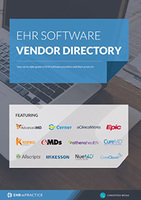Invest for MIPS success: the four S's of ophthalmology EHR
Now that the Merit-Based Incentive Payment System (MIPS) and value-based care model are in full effect, it’s important for ophthalmologists to evaluate where their practice stands to ensure they are well positioned for success.
Recent studies have shown that a growing number of specialty providers still feel under-equipped to support the change to being compensated for quality rather than quantity with their current EHR system. MIPS has created a switchers’ market when it comes to EHR systems. More physicians seek to invest in technology that not only makes these tasks and programs possible, but even more so to simplify them. Thinking about making a switch to a data-driven platform? Consider the ‘Four S’ Rule during the evaluation process. Your EHR system should be smart, structured, scored and specialized:
1. (S)mart
Intelligent systems that automate required reporting and administrative tasks allow physicians to focus more on clinical care and less on tedious admin work. A system with adaptive learning remembers each doctor's treatment preferences and unique style of practice - anticipating your next move and saving you time. Look for a vendor that offers analytics tools to document comparative benchmarking of quality and cost to peers, and illustrate financial visibility.
Real-time comparative benchmarking of both quality and cost data should not only show individual clinician performance and practice performance, but also where you fall when compared to other ophthalmologists.
2. (S)tructured
The ability to organize clinical data in a structured format makes up a key component to MIPS success. Structured data can extract meaningful insights at both the patient and population levels. It is actionable data, for example you can instantly pull out at any time what percentage of your postop cataract surgery patients are seeing better than 20/40.
Use this EHR comparison tool to find a suitable ophthalmology EHR for your practice
Such data is important for group analytics, research and obligations the government and payers place on physician groups. Employ an EHR system that can automatically capture the data you need at the point of care, so you can accurately build and report your composite MIPS score.
3. (S)cored
Your EHR should feature an easy-to-read MIPS scorecard right in the platform, allowing you to track your progress on each category including: Quality, Advancing Care Information (ACI) and Improvement Activities (IA), and in 2018 , Cost. Including these on your composite MIPS scorecard will help you observe your performance as measured and compared to peers across a number of different criteria and make adjustments as needed.
4. (S)pecialized
When we note ‘specialized’ it references two characteristics.
First, ophthalmology-specific knowledge and workflow by a vendor who employs practicing ophthalmologists means that you and your staff don’t have to take time to customize the software after purchase.
Second, specialized registries can make MIPS compliance easier and help you earn bonus points, possibly increasing income. Active engagement with a clinical data registry falls under the ACI and IA categories for MIPS, and working with a vendor that is also a qualified specialized health registry and can submit on your behalf can increase your MIPS score. This enables you to report data to disease-specific ophthalmologic registries and saves you time by eliminating the need for you or your staff to enter data into third-party systems for submission.
Having the right EHR system in place can help ensure your practice achieves success with MIPS. While there are many components to consider when choosing a new EHR, keeping the “Four S’” model in mind is a great place to start – smart, structured, scored and specialized.
Free white paper

EHR Vendor Directory
Get the most up-to-date directory of EHR software vendors. Find the best software for your practice.

Featured white papers
Related articles
-

EHR requirements and key features: your complete guide
Our extended guide to EHR requirements - everything you need to know and more on the subject
-

Top ophthalmology EHRs for your selection shortlist
Got your eye on a new ophthalmology EHR? Here are some top contenders.
-

Top oncology EHRs to kickstart your selection shortlist
Learn about some of the leading oncology EHR systems on the market including CureMD, ARIA Oncolog...



